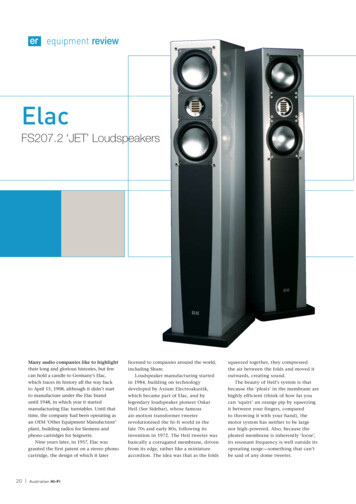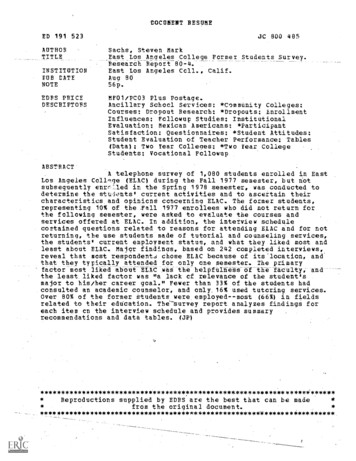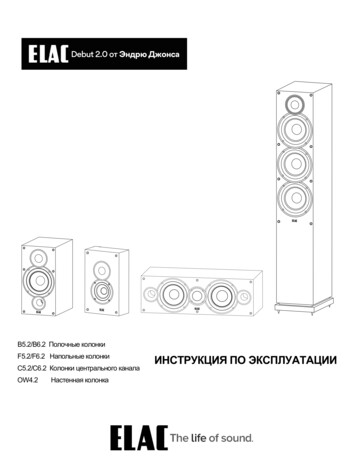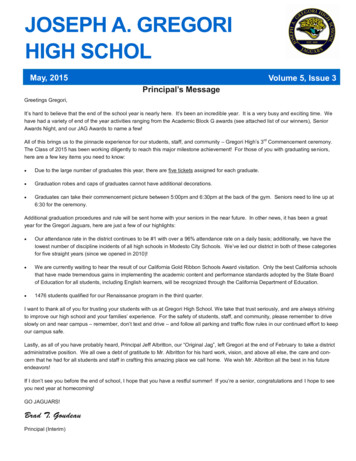
Transcription
er equipment reviewElacFS207.2 ‘JET’ LoudspeakersMany audio companies like to highlighttheir long and glorious histories, but fewcan hold a candle to Germany’s Elac,which traces its history all the way backto April 15, 1908, although it didn’t startto manufacture under the Elac branduntil 1948, in which year it startedmanufacturing Elac turntables. Until thattime, the company had been operating asan OEM ‘Other Equipment Manufacturer’plant, building radios for Siemens andphono cartridges for Seignette.Nine years later, in 1957, Elac wasgranted the first patent on a stereo phonocartridge, the design of which it later20 Australian Hi-Filicensed to companies around the world,including Shure.Loudspeaker manufacturing startedin 1984, building on technologydeveloped by Axium Electroakustik,which became part of Elac, and bylegendary loudspeaker pioneer OskarHeil (See Sidebar), whose famousair-motion transformer tweeterrevolutionised the hi-fi world in thelate 70s and early 80s, following itsinvention in 1972. The Heil tweeter wasbasically a corrugated membrane, drivenfrom its edge, rather like a miniatureaccordion. The idea was that as the foldssqueezed together, they compressedthe air between the folds and moved itoutwards, creating sound.The beauty of Heil’s system is thatbecause the ‘pleats’ in the membrane arehighly efficient (think of how far youcan ‘squirt’ an orange pip by squeezingit between your fingers, comparedto throwing it with your hand), themotor system has neither to be largenor high-powered. Also, because thepleated membrane is inherently ‘loose’,its resonant frequency is well outside itsoperating range—something that can’tbe said of any dome tweeter.
ElacOver the years, Heil’s basic tweeterdesign has been developed and producedby several different manufacturers aroundthe world and marketed under severaldifferent names, including AVT (AirVelocity Transformer) and Air MotionTransformer (AMT). Elac calls its versiona ‘JET’ tweeter.Elac’s JET tweeter is similar to theAdam company’s A.R.T. (AcceleratedRibbon Technology) tweeter, which isalso based on the original work of OskarHeil. Adam says the advantage of theHeil technology is primarily that ‘allother loudspeaker drive units, whetherthey are voice-coil driven, electrostatics,piezos or magnetostatics, act like apiston, moving air in a 1:1 ratio. Thisis undesirable, as the specific weightof air is much lower than that of thedriving mechanics. Speaking in termsof electrical engineering one could saythere is a bad match between source andload. The A.R.T. [JET] principle achievesa 4:1 velocity transformation between(the) driving diaphragm and driven air.In other words, the air moves in andout four times faster than the folds aremoving. This superior motor system isresponsible for the enormous clarity andtransient reproduction that is to be heardfrom the A.R.T. drive units.’For all its inherently superiortechnology, the JET tweeter looksremarkably ordinary—some might saydownright plain. Positioned midwaybetween the two bass/midrange driverson the upper portion of the FS 207.2’sfront baffle, the pleated diaphragm isalmost hidden behind five slots, eachof which is approximately 25mm wideand 5mm high, that are cut into theplastic faceplate. As with all the othercomponents used to build the FS 207.2,the tweeter is built in Germany by Elacitself. The crossover frequency (fromthe bass/midrange drivers) is relativelyhigh, at 2.7kHz, effectively removing anycrossover effects above the normal audiorange for fundamentals. The JET tweeterhas a high-frequency performance thatextends all the way up to 50kHz, so it’sideally suited to SACD and DVD-A, aswell as extended-range PCM. It’s worthnoting also, however, that there aremyriad acoustic benefits to be had fromextending tweeter response to 50kHzeven when using source music that’sband-limited to 20kHz, such as ordinaryCDs, as demonstrated by TsutomiOohashi et al in their paper ‘HighFrequency Sound Above the Audible RangeAffects Brain Electric Activity and SoundPerception.’Elac’s technology isn’t limited to justthe JET tweeter: the two bass/midrangedrivers used in the FS207.2 are also quiteunusual, which you might guess even bylooking at them, because of the oddlycast frames and the shallow, dish-likecone structures. Instead of the conesbeing made from just the one material,Elac’s engineers bond a thin layer ofaluminium sheet to an underlying layerof wood pulp. The layer of aluminiumacts to stiffen the cone, so it operatesmore like a piston at low frequencies,Brand: ElacModel: FS207.2Category: Floorstanding LoudspeakersRRP: 3,200– 3,400Warranty: Ten YearsDistributor: Synergy Audio Visual Pty LtdAddress: 55 Down StreetCollingwoodVIC 3066T: (03) 9416 4161F: (03) 9416 4163E: info@synergyaudio.comW: www.synergyaudio.comOskar HeilInterestingly, several audiocentricwebsites credit Oskar Heil with theinvention of the field effect transistor(FET), and it seems appropriate inthis review to put that theory out ofits misery, because nothing could befurther from the truth.The FET was invented in 1927 by DrJulius Edgar Lilienfeld and patentedby him on March 7, 1930. Born inGermany in 1881, Lilienfeld emigratedto the US in 1927. Lilienfeld wasa genius who corresponded withAlbert Einstein. Not only did Lilienfeldinvent the FET, he also invented thefirst electrolytic capacitor (Patent#1,906,691, filed on March 28, 1928)and a solid-state rectifier (Patent#1,611,653, filed 1926). It seemsthe reason his work may have beenoverlooked or ignored is because inthe aftermath of WW1, when Lilienfeldwas still working in Germany, the USpatent office assigned the rights to allhis US patents to the Alien PropertyCustodian. It is certainly true thatOskar Heil patented a FET in Britain in1935 (Patent #439,457), but based onprior art rules, this patent should neverhave been allowed.To ward off those who wish todisagree with my interpretation, I’d liketo point out that Lilienfeld applied forthree patents in all. The first two, from1926 and 1928, describe what’s nowaccepted as the field-effect transistor(FET) structure. The first patent (J. E.Lilienfeld, A Method and ApparatusFor Controlling Electric Currents, USPatent #1,745,175, filed on October 8,1926, and granted January 18, 1930) isfor a MESFET or metal/semiconductorFET. The second patent (J. E.Lilienfeld, A Device For ControllingElectric Current, US Patent #1,900,018filed March 28, 1928, patented March7, 1933) is derived from the first andgives a description of a depletionmode MOSFET. The third patent (J.E. Lilienfeld, An Amplifier for ElectricCurrents, US Patent #1,877,140,application filed December 8, 1928,granted September 13, 1932) describestwo other transistor structures,the Metal Base Transistor or theSemiconductor/Metal SemiconductorTransistor (SMST) and the SchottkyBarrier-Collector Transistor or MSMT.(The word transistor had its beginningin 1946 in work at Bell TelephoneLaboratories that used high-puritygermanium to create a solid-stateamplifying device.) Re-inventionof transistors some twenty yearsafter the Lilienfeld’s work, by JohnBardeen, Walter Brattain and WilliamShockley earned these Bell TelephoneLaboratories employees three NobelPrizes, but Bell Labs was forced toabandon all patent claims to the fieldeffect transistor because of Lilienfeld’sprior art. Over his lifetime, Lilienfeldwas granted fifteen German patentsand sixty US patents, amongst whichwas one for a particularly innovativeloudspeaker (Patent #1,723,244).Australian Hi-Fi 21
erElac FS 207.2 Loudspeakersso reducing distortion, while the woodpulp backing prevents the aluminiumfrom ‘ringing’ at high frequencies. Inother words, you get all the advantagesof a metal-cone driver without any ofthe disadvantages! The drivers are ratedwith a diameter of 150mm, but theirTheile/Small diameter is much smaller, at117mm. The chassis is made from pressedsteel, at the business end of which isa very large, heavily shielded doublemagnet assembly. This drives a voice coilwound on a Kapton former.Heavy-duty Figure-8 cables run fromthe JET tweeter and the bass/midrangedrivers back to the crossover network,which is PCB -based and mounted to therear of the rear terminal plate. Becausethe FS207.2 is set up for bi-wiring, thereare actually two completely separatefilter networks, each on its own PCB.The HF section has three 100V nonpolarised electrolytics, three inductors,four ceramic resistors as well as twopolypropylene capacitors and a positivetemperature coefficient resistor (Protec).The LF section is comprised of fourinductors, five ceramic resistors and threenon-polarised electrolytics. What I foundmost interesting was that the PCB hasa movable link marked ‘Jet Level 0’ and‘Jet Level 1’ indicating that it’s possibleto adjust the high-frequency level ofthe tweeter by 1dB, though this is notmentioned in any of Elac’s literature. Thelink on my sample was set to ‘0’, where Ileft it (about which more later).The tall FS207.2 is a bass reflexenclosure with two ports that exitthrough the rear of the cabinet. I wasintrigued to find that Elac provides twofoam plugs that can be used to modifythe low-frequency performance of theFS207.2, but provides no information onhow the plugs should be used. A flurryof email exchanges with local distributorSynergy Audio Visual revealed that Elacdoesn’t recommend blocking both portsbecause the drivers in the FS207.2 werenot designed for use in a sealed enclosure,and that the choice is whether to blockthe top or the bottom port, to modify thebass response according to where in theroom the speakers are located.Elac says that in its experience,blocking the upper port is usuallysufficient to tame any excess bass, butif not, the lower port should be blocked22 Australian Hi-Fiassembly is required, as they say, becausethe speaker base comes packed separatelyfrom the speakers, but it’s only fourscrews per base, which is an easy ask. Thecabinet comes in three finishes. A pair ofFS207.2s with a cherry veneer finish costs 3,200. Silver and titanium finishes are alittle extra: 3,400 per pair. The warrantyis 10 years on the drivers and 3 years onthe cabinets.Listening Sessionsinstead. Remember, too, that if you’renot locating the speakers in ‘mirrorimage’ locations, so that the ports in eachspeaker are equally loaded by nearbywalls, it’s not necessary to have identicalplug configurations. For example, if onespeaker has a wall alongside and theother doesn’t, you could insert a plugonly in the speaker close to the wall, tobetter-match the bass output to that ofthe other channel.Size-wise, I thought Elac had struck aperfect balance with the FS207.2s. At just935mm high, 170mm wide and 285mmdeep, they’re visually appealing fromvirtually any angle, with or without thegrilles fitted. This size enables a goodinternal volume, as well, in the orderof 43 litres, to help out the bass. SomeMy listening room is set up so that theleft speaker sees exactly the same ‘roomload’ as the right speaker, so I had onlyto work out whether I preferred thesound of the speakers with the top holesplugged, the bottom holes plugged orwith both ports left completely open. Tomy mind, there was no doubt that thebass seemed punchier and more dynamicwith the ports left open, and this is,for the most part, the alignment I usedthroughout my time with the FS207.2s.That said, I have to say that with somerock albums, particularly those masteredin the 80s, I found the level of the basscould be just a little too elevated, atwhich point I found that blocking off thetop ports worked a treat. Yes, I lost a littleof the punch and dynamism in doingso, but the balance came right back intoline. I didn’t run into any situation whereI found the need to block the bottomports with anything other than orchestralmusic, where I found blocking the lowerport seemed to give a smoother, moremelodious feel to the orchestra’s lowerpitched instruments.As for working out which way Ishould set that internal jumper, I didn’t.I decided that room acoustics andspeaker positioning would affect thehigh-frequency response by more than1dB and so that it would be fairer to allconcerned to listen using the ‘factoryset’ position. All I can say is that youshould also do this and if, after severalmonths, once you’ve become thoroughlyaccustomed to the sound, you thinkyou could do with a little lift in thehighs, switch the jumpers over thenand only then. Having decided this, Ican honestly say there wasn’t a momentduring my time with the FS207.2s—withany type of music—that I thought I’dmade a bad call in leaving the jumpersin their original position.
Which is by way of saying that I foundthe balance of the sound was superb. Theweight of the bass meshed perfectly withthe delivery of the midrange, which thensegued so effortlessly into the treble thatthere was not even the slightest sense ofthere being a transition from one driverto another. The sense of naturalness tothe sound that this imbues cannot beoverstated, particularly with instrumentsthat have a wide frequency range, such askeyboards of all kinds. I was particularlyreminded of this when playing a new CD(‘Transcriptions of Concertos after Vivaldiand others’ on Void 9813 A/B—it may bedifficult to obtain!) by Dutch pianist IvoJanssen, who’s undertaken the somewhatdaunting task of recording all Bach’skeyboard works. The recording capturesthe sound of Janssen’s Yamaha C7 toperfection. It could be the best-recordedpiano I’ve ever heard.The Elacs handled keyboard soundwonderfully well, capturing the attackand sustain and excelling at the extremes,delivering depth to the bass and pearlytrills in the upper reaches. The JET tweeterproved absolutely brilliant not only atthe reproduction of pianoforte, but alsoreproducing harpsichord and harp, wherethe clarity and purity of the sound in thehigher octaves were second to none.That said, it’s actually more importantto get the midrange right, and here Elachas scored big-time, because the soundis exactly neutral, yet doesn’t have the‘soft’ sound that most speakers acquire inthe process of attaining this neutrality.Indeed the Elac midrange is light, airyand immediate, sounding forward withoutbeing forward, and ‘full of life’ withoutbeing bright. The performance is so goodthere’s not even the slightest suggestionwhen listening that one musical stylemight be handled by the speakers betterthan any other; the Elac FS207.2 takeseverything in its stride, from rock, tojazz, to popular, through the various‘world music’ sub-genres. The clarity andcrispness on vocals is revelatory—youwon’t be straining to decipher a lyric ifyou own a pair of FS207.2s!Bass performance is commensuratewith the FS207.2’s physical size andthe size of its bass/midrange drivers interms of extension, comfortably reachingdown into the lowest octaves at normal24 TEST RESULTSElac FS 207.2 LoudspeakersAustralian Hi-Filistening levels, but not exhibiting whatI’d term ‘big’ bass when driven at veryhigh volume levels. Anything it lacks inraw power at the very deepest frequenciesit more than makes up for with a taut, drylow-frequency presentation that permitsyou to follow bass lines without thinkingabout it and to easily discriminate thepitch of even the shortest of bass notes.There’s also none of the overhang or bass‘bloom’ that affects large paper-conedbass drivers.In the course of connecting severaldifferent amplifiers to the Elac to establishtheir amplifier-friendliness, I discoveredthey were not particularly tolerant ofpoorly designed amplifiers: you reallyneed a good-quality audiophile amplifierto give it the freedom to perform at itsbest: an AM/FM or AV receiver reallywon’t cut it at all unless it has a properlydesigned output stage using discreteoutput devices.ConclusionGerman engineering has been one ofthe world’s marvels for many decades(think BMW, Mercedes, Porsche ) so it’sreally no surprise that the Elac FS207.2loudspeakers follow in the same finetradition. Superb engineering, superbsound quality, and a design that really isdifferent from the ‘me too’ approach thatcurrently plagues the hi-fi loudspeakermanufacturing industry. And as for that JETtweeter: count me as a convert!greg borrowmanLABREPORTerReaders interested in a fulltechnical appraisal of theperformance of the ElacFS207.2 ‘JET’ Loudspeakersshould continue on andread the LABORATORYREPORT published onthe following pages. Allreaders should note thatthe results mentioned inthe report, tabulated inperformance charts and/ordisplayed using graphsand/or photographs shouldbe construed as applyingonly to the specific sampletested.Test ResultsFigure 1 shows the performance of theElac FS207.2 with a wideband pink noisestimulus. Note that there’s no smoothingapplied to the trace, which means thatthe frequency response between 200Hzand 10kHz in particular is exceptional,not only for its general smoothness andlinearity, but also because of the overallflatness. As you can see from the scaleto the left of the graph, the graphedfrequency response extends from 80Hz to30kHz 2.5dB, and both the upper andlower limits are forced on the speaker bylimitations of the measurement processitself: the low frequency response by thesize of the room in which the speakerswere measured, and the high-frequencyresponse by the 30kHz upper limit of thegraph itself.Figure 2 shows a high-resolutionversion of the high-frequencyperformance of the Elac FS207.2,measured using a sine stimulus that wasgated to remove room effects to returna true anechoic response. Again on thisgraph you can admire the superb linearityof the Elac’s frequency response, as well asits high-frequency extension, particularlyabove 20kHz. The crossover between thebass/midrange drivers is just visible onthis graph, at 3.1kHz, just a fraction overthe claimed nominal 2.7kHz. Such a highcrossover frequency allows the midrangesound to be more uniform. The ‘dip’ inthe response at the crossover point, visiblebetween 2.7 and 3.5kHz is only around1dB, which is a fantastic result. Note alsothe response above 10kHz is fractionallyhigher than it is when pink noise is used.This is because the high-level pink noisestimulus thermally stresses tweetersbeyond what they’d normally experience.The response using the sine stimulus inthis graph is what you’d expect with amusic signal. Despite this, the differencebetween the two traces is very small, soin this regard, the JET tweeter performsbetter than any other tweeter AustralianHI-FI Test Laboratories has ever tested.Note also if the level of the tweeter werelifted by 1dB using the internal jumpers,the measured performance would be evenflatter than it already is.The third graph in the series (Figure3) shows the low-frequency performanceof the Elac FS207.2 acquired using a
er26 Elac FS 207.2 Loudspeakersnear-field measurement technique toeliminate room effects. The black traceshows the frequency response of thehigher of the two bass/midrange drivers.You can see that at 250Hz, where thelower bass/midrange driver starts rollingoff, its response continues out flat tobeyond 800Hz. (The reason the responseappears to roll off at 800Hz on the graphis due to a limitation of the near-fieldmeasuring technique that means thatbecause of driver size/mic spacing, there’sno longer a pressure field). The red traceshows the response of the lower of thetwo bass/midrange drivers, and you cansee that it has slightly more output in theregion between 65Hz and 175Hz than theupper bass driver. The blue trace showsthe output from the higher of the twobass reflex ports when the vent is open,while the green trace underneath showsthe response when the port is plugged.Without the plug, the response is quitepeaky, with the maxima at 43Hz. Withthe plug, the output is flattened, and theoutput reduced considerably (obviously!).Figure 4 shows impedance traces of theleft and right speakers (without any plugsfitted) overlaid over each other, plus athird impedance trace run with one of theplugs inserted, as well as a fourth tracemeasuring the resistance of a precision3: resistor for calibration/comparisonpurposes. You can see that theimpedances of the left and right speakersare virtually identical, which means themanufacturing processes and qualitycontrol procedures in place at Elac’sGerman factory are first-rate. With noplugs, the resonant peaks are at 34Hz and70Hz respectively. The minima betweenthem, at 45Hz, coincides almost perfectlywith the port’s maximum output. As youcan see, the impedance of the FS207.2design is quite low, staying below 4: from130Hz right up to 1.2kHz, so the speakersdefinitely deserve their 4: nominalrating. Elac specifies the minimumimpedance as 3.4: at 220Hz. AustralianHI-FI Test Laboratories’ measurementsFigure 1: Pink noise frequency response(unsmoothed) at one watt at 1.0 metres.Figure 3: Nearfield frequency response of bothbass drivers and reflex port. (Note data forports has not been re-scaled to compensate fordifferences in radiating area.)Figure 2: Gated sine frequency response(unsmoothed) at one watt, at 1.0 metres.Figure 4: Impedance vs frequency, with bothleft and right speakers graphed (see copy).Trace under is that of a reference 3: precisionresistor, measured at the same time forcalibration purposes.Australian Hi-FiTEST RESULTSput the impedance of the speaker testedjust a little lower at the 220Hz point(approximately 3.2:) and a bit loweragain (3.1:) up at 900Hz. The differencesare insignificant in an engineering (orpractical) sense, the issue is really thatElac specifying the minimum at 3.4: justscrapes the speaker into qualifying for anominal 4: impedance rating under theIEC 268-5 ruling, whereas 3.1: would havemeant a ‘nominal’ rating of 3.8:.Australian HI-FI Test Laboratoriesmeasured the Elac FS207.2’s sensitivity at87.5dBSPL at 1 metre, using an equivalent2.83V input, which is a little below Elac’sspecification of 89dBSPL, but AustralianHI-FI Test Laboratories’s measurementtechnique is unusual, and results in lowerfigures than the technique used by mostspeaker manufacturers. Taken together,the impedance and sensitivity resultsmean the Elac will efficiently convertamplifier voltage into sound pressurelevels, but will require the amplifier todeliver moderately high levels of currentin the process. Any amplifier that willhappily drive a 4: load continuously willshoo it in, but if you use an amplifier thatwill happily drive a 2: load continuously,so much the better.The last graph in the series (Figure5) is a composite graph in which thevarious differently-acquired traces havebeen joined using software to form asingle trace. This puts the measuredresponse at 55Hz to 30kHz 3dB. This isself-evidently excellent, and rememberthat the upper limit is the graph: the JETtweeter’s response extends to 50kHz.Steve HoldingFigure 5: Summed response (see copy).
Australian Hi-Fi 21 Brand: Elac Model: FS207.2 Category: Floorstanding Loudspeakers RRP: 3,200- 3,400 Warranty: Ten Years Distributor: Synergy Audio Visual Pty Ltd Address: 55 Down Street Collingwood VIC 3066 T: (03) 9416 4161 F: (03) 9416 4163 E: info@synergyaudio.com W: www.synergyaudio.com Elac Interestingly, several audiocentric websites credit Oskar Heil with the










